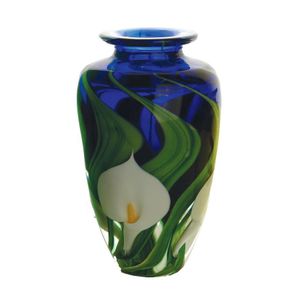Lalique Domremy Vase with Thistle Pattern
You must be a subscriber, and be logged in to view price and dealer details.
Subscribe Now to view actual auction price for this item
When you subscribe, you have the option of setting the currency in which to display prices to $Au, $US, $NZ or Stg.
- Patination / Patina - In broad terms, patination refers to the exterior surface appearance of the timber, the effect of fading caused by exposure to sunlight and air over the course of a century or more, changing the piece to a soft, mellow colour.
As patina is very difficult to replicate, it is one of the most important guides to determining the age of furniture.
Patina is also the term applied to the bloom or film found on old bronzes due to oxidisation. - Emeralds - Emeralds have been used in jewellery making for thousands of years, and are prized for their deep green colour, which is caused by the presence of chromium and vanadium in the mineral beryl. Because of their rare colour, emeralds are often more valuable than diamonds of a similar size and quality. In jewellery making, emeralds are typically cut into round or oval shapes to maximize their color and clarity. They are often set in gold or platinum and used as the centrepiece of a piece of jewellery, such as a ring or necklace. They can also be used in combination with other gems, such as diamonds, to create intricate and beautiful designs.
- Baluster (glass) - An architectural term for a column in a balustrade or staircase.
When used to describe glass, it can either refer to the shape of the stem of a wine glass, being slender above and pear shaped below, or the shape of the whole vessel, usually a vase. In fact the baluster shape is often described as being vase-like.
The description of a vase as being of baluster shape covers a wide variety of shapes that often bear no resemblance to the original architectural form.
This item has been included into following indexes:
-
Lalique (France), item types
- other items 1,054
- vases 536
- Lalique (France), patterns, vases - Domremy 10
- Schneider / Le Verre Francais (France) - lamps and lighting 301
Visually similar items

A Rene Lalique Domremy vase, designed 1926, the baluster body moulded with a continuous pattern of overlapping thistles, in frosted and opalescent glass with a grey patina, inscribed R. Lalique France, 21.3 cm high. Provenance: King David Gallery, Tel Aviv

A Wedgwood green earthenware monkey vase, circa 1932, by Erling Olsen (Danish), stamped Wedgwood Made in England, 23.5 cm high

A Peter Raos lily vase, cala lilies and leaves on a blue ground. Signed and dated 2002 to base. Height 14 cm

Charles Schneider Charder French glass vase signed & etched 'France' to base. Height 18.5 cm
